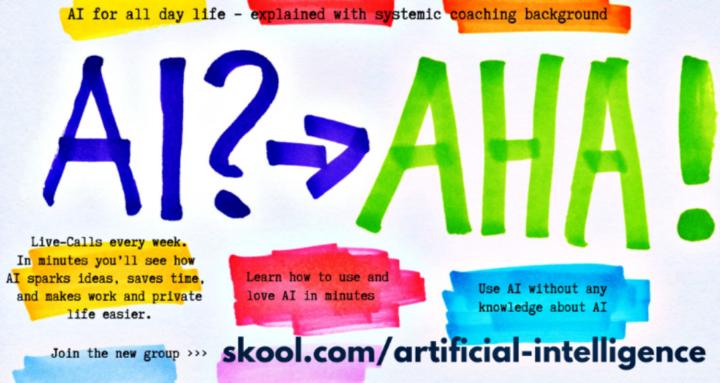
Write something
TJ - FingoChat – YouTube-Channel Recommendation
Thank you, @Joel Wilson, for recommending the wonderful LLM runs a shop-video in your community. This forces me to recommend the channel: https://www.youtube.com/@FingoChat/videos
Recommendation Systems and Personalization
Recommendation Systems and Personalization: Recommendation systems are Narrow AI engines that learn to predict what a user wants next — be it a movie, product, article, or connection. Personalization is the interface layer that applies these predictions to shape the experience: what appears first, what’s highlighted, what’s suggested in context. Together, they optimize attention, retention, and satisfaction by adapting content to individuals or segments in real time. The core challenge lies in sparse signals, shifting preferences, and the need to balance relevance with diversity. Explained for People without AI-Background - A recommendation system guesses what you might like based on your past actions and others similar to you. - Personalization means that what you see is tailored — different people get different results on the same app. Collaborative Filtering: Preference By Peer Pattern - User–Item Matrix – Treats history of likes, views, purchases as signals in a sparse grid. - Similarity Scores – Recommend what similar users liked using cosine similarity or latent embeddings. - Cold Start Problem – Struggles when there’s no interaction data for new users or items. - Matrix Factorization – Decomposes preferences into lower dimensions for better scalability. Content-Based Filtering: Profile Matching - Feature Vectors – Build profiles based on user traits and item attributes. - Matching Function – Recommend items with high overlap in keyword, genre, or category vectors. - No Peer Dependency – Works well for new users by exploiting metadata. - Limits – Tends to reinforce known interests without surfacing novel items. Hybrid Models: Combining Signals - Multitask Learning – Jointly train models on interaction and content data. - Graph-Based Approaches – Use user–item interaction networks to improve ranking. - Ensemble Pipelines – Blend collaborative and content scores with contextual signals. - Production Systems – Netflix, YouTube, and Spotify use hybrid and bandit-based models in production.
1
0
Task Specific Assistants – Chat, Code, and Image
Task Specific Assistants – Chat, Code, and Image: Task-specific assistants are the most commercially deployed form of artificial intelligence today. Unlike general-purpose AI models, they are optimized for single-use cases: writing, coding, or generating images. These systems excel not because they understand deeply, but because they are tightly scoped, highly trained, and paired with user interfaces that drive productivity. Chat assistants process language tasks like summarizing or replying. Code assistants predict useful program logic from context. In doing so, they reduce cognitive load, accelerate boilerplate generation, and help developers explore unfamiliar frameworks without starting from scratch. Explained for People without AI-Background - A task-specific assistant is like a smart helper trained for one job, such as writing, coding, or drawing. - It doesn’t understand the world, but it produces useful results within its focused task. - These assistants act fast and fluently when the request fits their design. Chat Assistants: Language Tasks On Demand - Pretrained Transformers – Use large-scale language models like ChatGPT, Claude, or Gemini to complete, summarize, translate, and restructure text. - Prompt-Aware – Align style and tone with instructions using system prompts and dialog context. - Grounded Retrieval – Integrate RAG (retrieval augmented generation) for fact-based answers in enterprise tools. - Modal Integration – Embedded into email, CRM, document editors, or browsers as in-place assistants. Code Assistants: Precision Autocompletion and Generation - Token Prediction – Trained on large corpora of source code to predict syntactically valid completions. - Multi-Language Support – Handle Python, JavaScript, Java, TypeScript, and more with framework awareness. - Inline Context Awareness – Suggest logic, generate test cases, and refactor based on full file and cursor position. - Deployment – Delivered via IDE plugins and browser extensions for low-latency in-editor experience.
1
0
Safety and Guardrails in Narrow AI Systems
Safety and Guardrails in Narrow AI Systems: Narrow AI systems, while focused and high-performing within their domain, can still produce unsafe, biased, or unpredictable outputs. Guardrails are design patterns and enforcement mechanisms that limit what an AI system can do — not just technically, but ethically and operationally. These include filtering harmful content, rejecting out-of-bounds queries, constraining model behavior, and escalating edge cases for human review. Safety isn’t a single model property but an emergent outcome shaped by training data, architecture choices, deployment context, and human oversight. Explained for People without AI-Background - Guardrails are like safety rails on a highway — they prevent the AI from going off course. - They block inappropriate or dangerous responses and involve a human when needed. Input Filtering and Access Control - Prompt Sanitization – Detect and reject inputs that include dangerous, malicious, or manipulative language. - Contextual Awareness – Refuse to answer in risky contexts (e.g., medical, financial) without disclaimers. - Access Boundaries – Restrict models from invoking unauthorized tools, files, or APIs. - Shadow Prompts – Internal system prompts define behavioral constraints invisible to the user. Output Filtering and Post-Processing - Toxicity Detection – Use classifiers to remove hate speech, slurs, or offensive phrasing. - Privacy Scrubbing – Detect and redact PII like phone numbers, emails, or sensitive details. - Bias Mitigation – Rephrase outputs that reinforce harmful stereotypes or one-sided perspectives. - Response Shaping – Add disclaimers, soften absolutes, or adjust tone to suit audience and context. Escalation and Human-In-The-Loop Design - Confidence Thresholds – Suppress outputs when the model is unsure or the answer is ambiguous. - Human Escalation – Route flagged cases to human operators or reviewers in enterprise systems. - Feedback Loops – User ratings, edits, or reports influence model retraining or filtering logic.
1
0
Edge AI and On Device Intelligence
Edge AI and On Device Intelligence in Narrow AI: Edge AI refers to running machine learning models directly on local devices — phones, cameras, sensors, wearables — without requiring a connection to centralized servers or the cloud. This architectural shift makes AI faster, more private, and more resilient. Instead of sending data to be processed remotely, inference happens right where the data is generated. From wake word detection and predictive text to driver assistance and personal health tracking, Edge AI powers real-time, context-sensitive interact... Explained for People without AI-Background - Edge AI means the intelligence is inside your device — not somewhere on the internet. - It lets the system work even without a signal, and respond faster while protecting your data. Why Edge AI Matters - Latency Reduction – Local inference avoids round-trip delays to cloud services. - Privacy and Sovereignty – Sensitive data stays on device; useful for healthcare, finance, and personal use cases. - Bandwidth Optimization – Reduces upstream data flow in high-volume sensor environments. - Resilience – Works in offline or low-connectivity settings (e.g., airplanes, rural areas). Core Technologies and Tooling - Lightweight Frameworks – Use TensorFlow Lite, CoreML, PyTorch Mobile, and ONNX Runtime for model deployment. - Hardware Acceleration – Leverage NPUs, GPUs, DSPs in mobile chipsets for low-power inference. - Compilation and Optimization – Use tools like TVM or Glow to adapt models to target hardware and reduce memory footprint. - Model Formats – Quantization, pruning, and weight clustering are used to shrink models while maintaining accuracy. Applications in the Wild - Phones – Face unlock, camera enhancements, predictive typing, real-time translation. - Cars – Driver monitoring, pedestrian detection, and parking assistance. - Wearables – Heart rate anomaly detection, gesture recognition, contextual coaching. - Industrial IoT – Defect detection, vibration analysis, and predictive maintenance.
1
0
1-8 of 8

skool.com/artificial-intelligence
Artificial Intelligence (AI): Machine Learning, Deep Learning, Natural Language Processing NLP, Computer Vision, ANI, AGI, ASI, Human in the loop, SEO
Powered by



